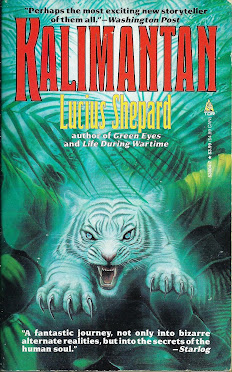Every Now and Then......
........I discover that my website provides a 'blurb'.
So it is in the case of this DAW book from 2013, where my review was used to fashion a back cover blurb......
Certainly this is every blogger's aspiration (?!)
SO....what's a PorPor Book ? 'PorPor' is a derogatory term my brother used, to refer to the SF and Fantasy paperbacks and comic books I eagerly read from the late 60s to the late 80s. This blog is devoted to those paperbacks and comics you can find on the shelves of second-hand bookstores...from the New Wave era and 'Dangerous Visions', to the advent of the cyberpunks and 'Neuromancer'.
Every Now and Then......
........I discover that my website provides a 'blurb'.
So it is in the case of this DAW book from 2013, where my review was used to fashion a back cover blurb......
Certainly this is every blogger's aspiration (?!)
For April 2021, we'll be reviewing five novels that represent 'modern' cyberpunk.
This of course begs the question: what do I mean by 'modern' cyberpunk ?
Well, if we use William Gibson's novels as a guide for both thematic and publishing histories, I would call the 'Sprawl' trilogy (Neuromancer, 1984; Count Zero, 1986; Mona Lisa Overdrive, 1988) first-generation cyberpunk.
The 'Bridge' trilogy (Virtual Light, 1993; Idoru, 1996; All Tomorrow's Parties, 1999) represents second-generation cyberpunk.
And the 'Blue Ant' trilogy (Pattern Recognition, 2003; Spook Country, 2007; and Zero History, 2010) represents third-generation cyberpunk.
So 'modern' cyberpunk is represented by novels published during the second- and third- generations of the genre, i.e., during the period bounded roughly by the mid-1990s to the mid 2000s.
The five novels being reviewed all share some themes common to modern cyberpunk. For example, there is a healthy regard for paranoia, as every transaction - purchases, phone calls, and emails - is recorded, and even walking on the street is documented by closed-circuit television cameras (The Traveler, Whole Wide World).
Another prominent theme is the advent of megalomaniacal AIs or supercomputers (The Deus Machine, Black Glass, Daemon). Misuse of biotechnology is showcased in The Deus Machine, and also features in The Traveler.
And overarching all these themes is the grander theme of dehumanization at the hands of faceless, all-powerful corporate entities.
One thing's for sure: the five books pictured above all are lengthy. The Deus Machine is over 500 pp. long, Whole Wide World is 376 pp. long, Daemon is 640 pp. long. Sci-fi novels published during the interval from 1968 - 1988 rarely were that lengthy.........Dhalgren was the exception, not the rule. It's an indication of how much has changed since the days when it wasn't unusual for a sci-fi novel to be under 200 pages in length.............
Courtesy of 'The Drawings of Steranko' website, a nice, three-page gallery of Jim Sternako's illustrations for sci-fi, western, adventure, and fantasy paperbacks published in the 1970s and 1980s is available at this link.
The website has lots of additional media done by Sternako, and is well worth checking out.

